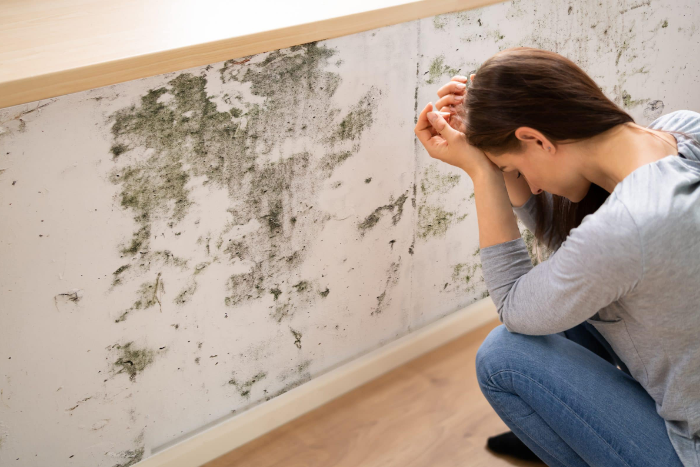
Campaign tackles damp homes
A new campaign to raise awareness about damp and mould in homes has launched in the Lincoln area to help tenants and landlords understand their rights and responsibilities.
West Lindsey District Council’s campaign is aimed at raising awareness about the health risks associated with damp and mould in homes and ways in which these issues can be tackled.
Emily Bond, project coordinator explained the long-term benefits of this educational campaign: “By raising awareness and providing accurate information, we hope to empower residents and landlords to take proactive steps in preventing and addressing damp and mould in their properties.
“Education is key – it will improve the situation not just now, but for years to come. People need to know when to act rather than ignoring the problem, thinking it will resolve itself.”
Information around the importance of taking the appropriate action seeks to break down the myths surrounding damp issues, and will provide valuable insights into the differences between rising damp and black mould.
The objective of the campaign is to create a better understanding between tenants and landlords on their rights and responsibilities, to ensure any issues are resolved appropriately.
“Damp and mould can be a huge problem in the private rented sector and we have seen people at the end of their tether, who don’t know their rights, don’t know what to do and are too frightened to say anything in case they lose their homes,” added Emily.
"Some people bury their heads and think it’s not a problem, but the issues can multiply, and it just will not go away on itself. We hope we can start the conversations and give advice on actions that can be taken to solve and prevent any further issues.”
The six-month campaign is a direct response to address problems that were highlighted following the tragic death of two-year-old Awaab Ishak, who died from prolonged exposure to damp and mould in a social property in Rochdale.
The toddler’s death sparked a nationwide review to ensure every landlord takes action so that none of their tenants have to live in conditions that put their health and safety at risk.
“It is important that we highlight the significant health impacts associated with damp and mould and that our residents understand the urgency of addressing these problems promptly,” said Cllr Lesley Rollings, Chairman of the Prosperous Communities Committee at the Council.
“We hope that by promoting this knowledge, we can help create healthier living conditions for all residents, particularly those in the private rented sector and housing associations, where these issues are most prevalent.”
A series of free information sessions are available for landlords to attend, to help navigate important topics such as damp and mould, tenants’ rights, and changes in legislation. These sessions provide a crucial insight for both new landlords and those who have been in the business for years, to ensure that they are compliant with current legislations and aware of upcoming changes.
The same session will run on November 14 (6pm – 7.30pm) and December 9 (1pm – 4pm) and aims to teach landlords about their legal responsibilities, with the opportunity to have any questions answered by expert speakers.
To find out more about the upcoming Landlord Damp and Mould Training Sessions, visit www.west-lindsey.gov.uk
Tips to combat mould
Drying Clothes
Dry your clothes outside, if this is not possible due to bad weather or lack of outdoor space use an airer to dry clothes rather than placing wet clothes directly onto a radiator. Although this can be quicker it creates a lot of moist air in a short amount of time which can become condensation. It is also important to consider where you are drying clothes, setting up your airer in a kitchen or bathroom with ventilation would be better than leaving it in a carpeted, highly frequented room such as the living room.
Windows
Wipe any condensation that forms on your windows, especially in the mornings, with a dry cloth. Open the bedroom windows briefly in the morning to let dry air in. Whilst cooking or bathing open your windows to allow damp air to escape.
Furniture
Leave a gap between walls and furniture. Leave the top of wardrobes clear and do not overfill drawers or cupboards. This will allow air to circulate and prevent mould forming behind or inside of furniture.
Heating
Try to heat your home evenly to avoid cold areas. Warm air will enter these areas and form condensation. To avoid major condensation problems the temperature in your home should not drop below 14 degrees Celsius.
Cleaning existing Black Mould
If you already have mould in your house this needs to be killed to stop it from spreading. It is important to remember that mould is a fungus and is harmful to health. It spreads through the air via spores so whilst removing it you should wear gloves, goggles and a mask, especially if you suffer from any breathing problems.
To begin, remove any spores with a soft brush or vacuum cleaner. Following this you will need to clean the area thoroughly to ensure that all of the mould is removed with antifungal spray, diluted bleach or white vinegar.
Spray the detergent onto the affected area and leave for up to an hour. Using a soft cloth, scrub the area until all visible mould has gone. Make sure the area is thoroughly dried and the room remains consistently warm to prevent regrowth.
If you think you have rising damp or penetrating damp caused by structural defects, speak to the housing standards teams.
